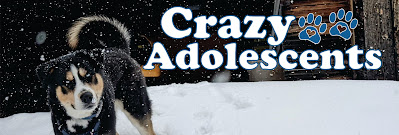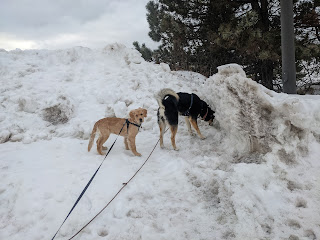Adolescent dogs often struggle most with distractions that are beyond our control. This can be other people and/or dogs we meet while out on a walk, wild animals or pets that pop up unexpectedly, or any of a million other things that our dogs might react to. However this is NOT the place we want to start with training sessions.
If you want to help your dog succeed around distractions, you first have to teach them the skills to succeed on a no or low distraction environment. All training should start at home! There are a ton of games you can play to help teach your dog the skills they need to succeed while increasing your skills as a team. We are going to be going over lots of these games in the FAD Mini-workshop that is quickly approaching! If you haven't registered already, please do so here.Yooper Paws of Love is dedicated to providing training with love to you and your 4-legged friend! My mission as a trainer is to EDUCATE owners to ENGAGE better with their dogs to EMPOWER them to function as an effective team together. As a trainer, I help families & their dogs learn to enjoy each other’s company by developing a teamwork and games based approach to dog training that is as individualized as the family I’m helping!
Friday, March 11, 2022
Training Around Distractions
Tuesday, March 8, 2022
Considering How The Environment Affects Distractions
What is your dog's #1 Distraction?
I'm going to use Azul's love of making new doggy friends for this example. As a frequent dog park attendee (with extreme caution), Azul has such a love for this location that he starts loosing his mind at 8 blocks away due to excitement. My normally, calm & quiet teenager turns into a loud, obnoxious teenager going to the amusement park to ride the rollercoasters. If my intended training session is to help Azul switch back and forth (engage & disengage) while in a high arousal state, I might choose this location. However, if my goal for the session is to practice leash manners I'd be choosing the wrong environment for that and setting us both up to fail.
Being winter weather and not being able to get out as frequently as we'd like, Azul's outdoor leash manners need some spring touch ups. This means that I'm going to choose some more remote locations to practice leash skills where Azul can stay in a calmer, less aroused emotional state. One of our favorite places to walk last fall was a 1 mile loop around Strawberry Lake. But this being one of the only paved and plowed paths in our area during the winter so this path is used frequently by dog owners. Add in the snowbanks on the sides of the trail, and this limits our ability to move off to the side if another dog is passing. Three walks in a row we were met by new dogs in the same short stretch on the back side of the lake. On the fourth walk, Azul had difficulties focusing at this part of the trail in anticipation of meeting a new friend there. And since this was mid-walk, Azul's energy remained higher the rest of the walk.
Now setting that location up for success, I made a few changes to make that section of the trail non-eventful. First, we altered our time to earlier morning before the temps became more tolerable to others. Second, we parked at the back lot where we could walk towards this spot or away from it depending on how Azul was able to focus. This made the trouble area first or last in walk instead of right in the middle! I decided to do it first because the other lots at the other side were still empty allowing me to reasonably expect no new greetings at this same location right away. This also helped Azul walk slower because he wanted to sniff all the p-mail more extensively. I was able to wait till we were passed the trouble area before asking Azul to give me a bit more focus. At the end of the walk, I was able to put Azul's longline on in the empty parking lot where I could do some work and he could watch dogs on the trail from a safe distance, without interacting.
Now for the picture at the top of the page. This environment was chosen for a very different reason! I have Azul and puppy Roz who both need some decompression sniff-a-bouts and a chance to potty before we go inside a pet store for training. But the 2 have not had a chance for off leash play yet and Roz has no longline skills yet. So I chose a spot behind an empty building near the pet store as it was plowed for safe walking, but I could reasonably expect no other cars or dogs to enter our environment.
We chose the pet store as our first indoor walking location so I could let the dogs move more freely and observe Roz to see if she would be just as confident and happy walking with us as she was walking with her person earlier in the day. Pet stores are super distracting locations for young pups so we didn't do any work on her leash manners here. The goal of the session was for me to watch and observe the interactions between Azul and Roz in a higher arousal environment.
Now fast forward a day, and change to a much less arousing store environment and Azul and I were able to begin teaching Roz some indoor leash skills. Here you can see how quickly Little Miss Roz is learning her heel position in the right environment for the session.
So before you head out to do any training session, think about what are your chances of running into your dog's biggest distractions in the environment and what are your goals for this outing. Set your team up for success by matching the environment to the arousal level you want to work at during that session. Don't just head out and hope for the best because that rarely happens unless we make good choices about our environment.



